Blank L., Tarquin A. Engineering Economy (McGraw-Hill Series in Industrial Engineering and Management)
Подождите немного. Документ загружается.

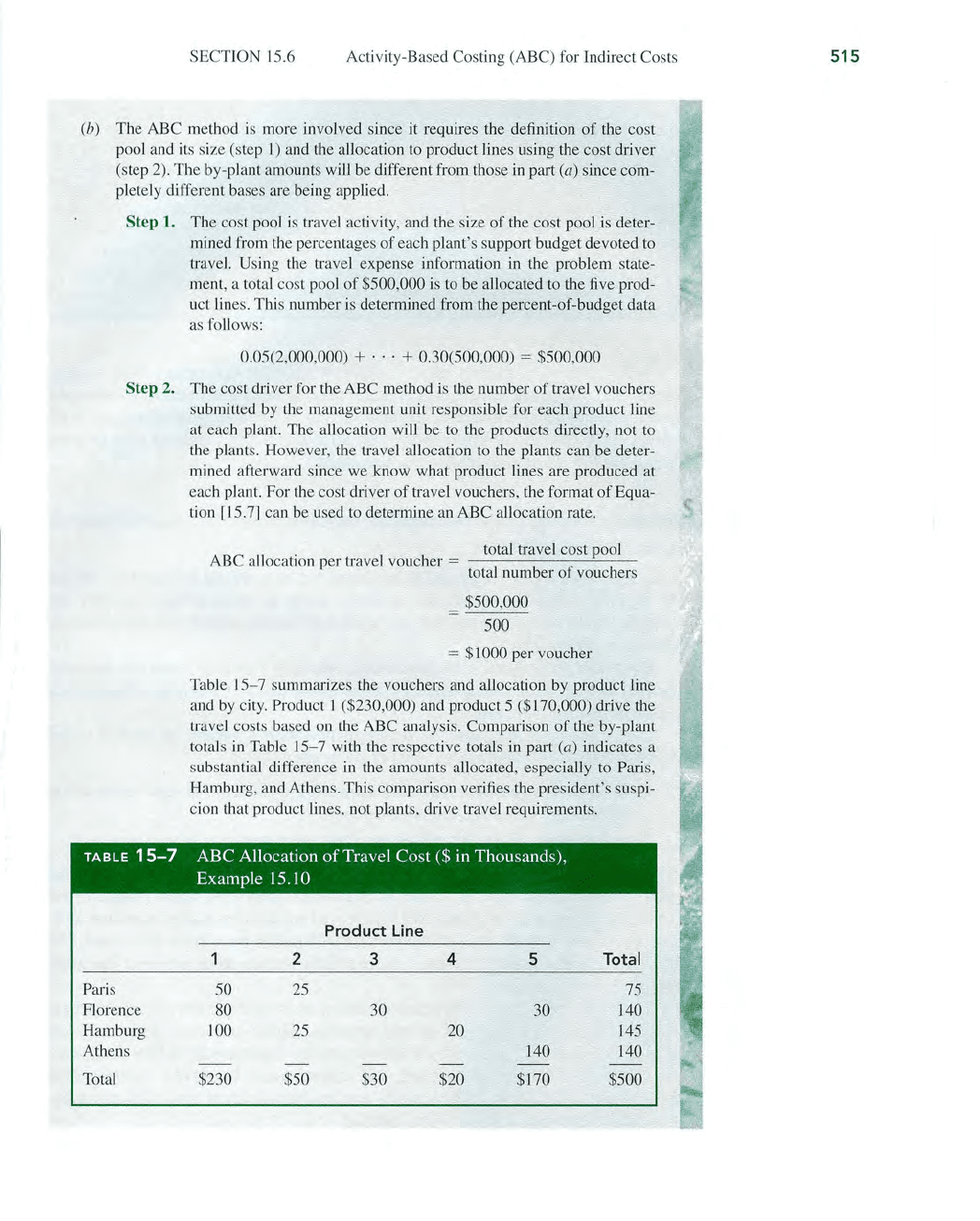
SECTION 15.6 Activity-Based Costing (ABC) for Indirect Costs
(b) The ABC method is more involved since it requires the definition
of
the cost
pool and
it
s size (step
I)
and the allocation
to
product lines using the cost driver
(step 2). The by-plant amounts will be different from those
in
part (a) since com-
pletely different bases are being applied.
Step
1. The cost pool is travel activity, and the size
of
the cost pool is deter-
mined from the percentages
of
each plant's support budget devoted
to
travel. Using the travel expense information in the problem state-
ment, a total cost pool
of
$500,000 is
to
be allocated
to
the five prod-
uct line
s.
This number
is
determined from the percent-of-budget data
as
follows:
0.05(2,000,000) +
...
+ 0.30(500,000) = $500,000
Step
2. The cost driver for the ABC method is the number
of
travel vouchers
submitted
by
the management unit responsible for each product line
at each plant. The allocation will be to the products directly, not
to
the plants. However, the travel allocation to the plants can be deter-
mined afterward since we know what product lines are produced at
each plant. For the cost driver
of
travel vouchers, the format
of
Equa-
tion [15.7] can be used to determine
an
ABC allocation rate.
total travel cost pool
ABC a
ll
ocation per travel voucher =
----------'---
total number
of
vonchers
$500,000
500
= $1000 per voucher
Table
15
- 7 summarizes the vouchers and allocation
by
product line
a
nd
by
city. Product 1 ($230,000) and product 5 ($170,000) drive the
travel costs based
on
the ABC analysis. Comparison
of
the by-plant
totals
in
Table
15-7
with the respective totals
in
part (a) indicates a
s
ub
stantial difference in the amounts allocated, especially to Paris,
Hamburg, and Athens. This comparison verifies the president's suspi-
cion that product lines, not plants, drive travel requirements.
TABLE
15-7
ABC Allocation
of
Travel Cost ($ in Thousands),
Example 15.10
Product
Line
2
3 4
5
Total
Paris 50 25
75
Florence
80 30 30 140
Hamburg
100
25
20
145
Athens
140 140
--
Total $230
$50 $30 $20 $170 $500
515
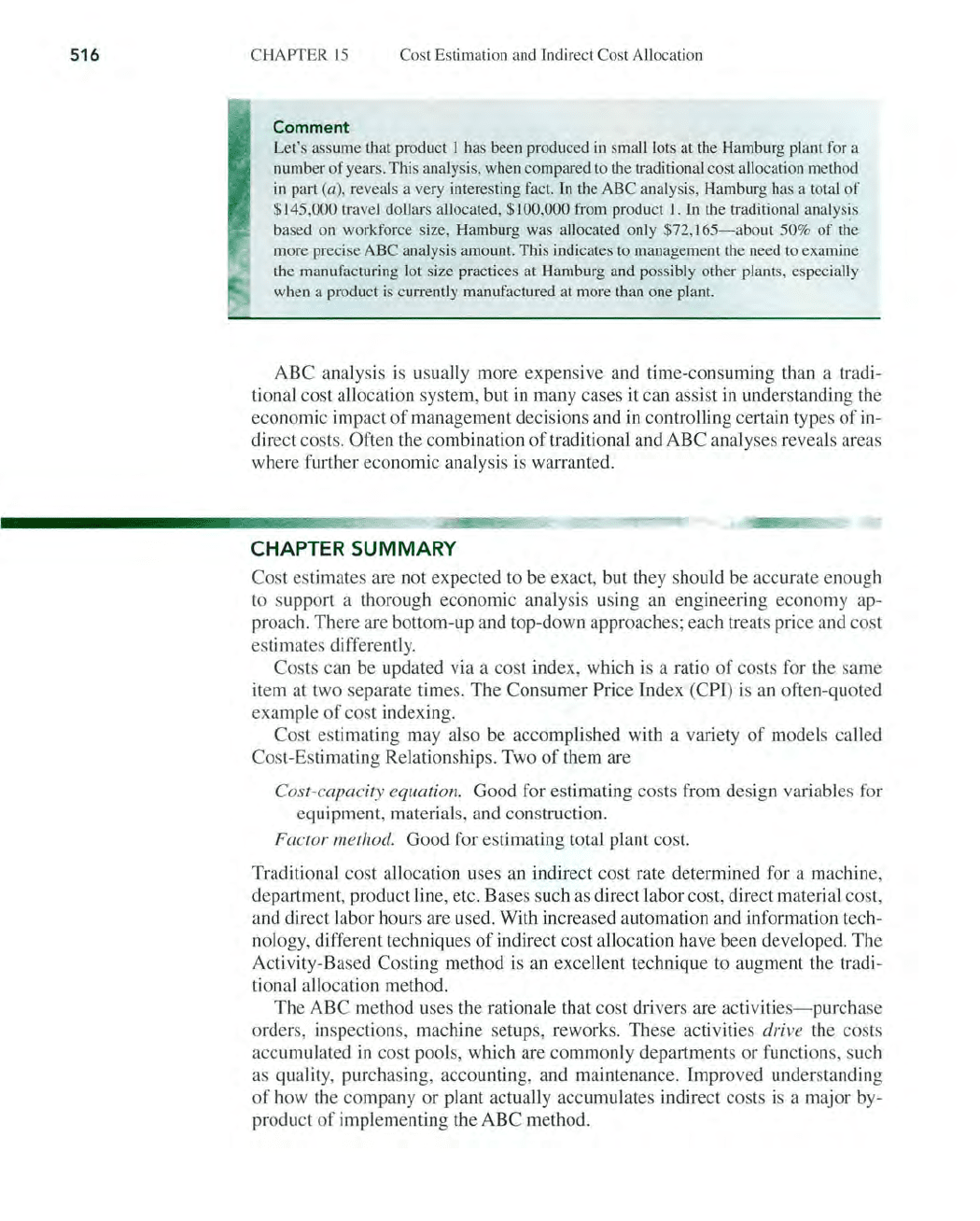
516
CHAPTER
15
Cost Estimation and Indirect Cost Allocation
Comment
Let's assume that product I has been produced
in
small lots at the Hamburg plant for a
number
of
years. This analysis, when compared to the traditional cost a
llo
cation method
in
part (a), reveals a very interesting fact. In the ABC analysis, Hamburg has a total
of
$145,000 travel dollars allocated, $100,000 from product
I.
In the traditional analysis
based on workforce size, Hamburg was allocated only $72,
165-about
50% of the
more precise ABC analysis amount. This indicates
to
management the need to examine
the manufacturing lot size practices at Hamburg and possibly other plants, especia
ll
y
when a product
is
currently manufactured at more than one plant.
ABC analysis
is
usually more expensive and time-consuming than a tradi-
tional cost allocation system, but in many cases it can assist in understanding the
economic impact
of
management decisions and in controlling certain types
of
in-
direct costs. Often the combination
of
traditional and ABC analyses reveals areas
where further economic analysis is warranted.
CHAPTER SUMMARY
Cost estimates are not expected to be exact, but they should be accurate enough
to support a thorough economic analysis using an engineeting economy ap-
proach. There are bottom-up and top-down approaches; each treats price and cost
estimates differently.
Costs can be updated via a cost index, which is a ratio
of
costs for the same
item at two separate times. The Consumer
Price Index (CPI) is an often-quoted
example
of
cost indexing.
Cost estimating may also be accomplished with a variety
of
models called
Cost-Estimating Relationships. Two
of
them are
Cost-capacity equ.ation. Good for estimating costs from design variables for
equipment, materials, and construction.
Factor method. Good for estimating total plant cost.
Traditional cost allocation uses an indirect cost rate determined for a machine,
department, product line, etc. Bases such
as
direct labor cost, direct material cost,
and direct labor hours are used. With increased automation and information tech-
nology, different techniques
of
indirect cost allocation have been developed. The
Activity-Based Costing method is an exce
ll
ent technique to augment the tradi-
tional allocation method.
The ABC method uses the rationale that cost drivers are
activities-purchase
orders, inspections, machine setups, reworks. These activities drive the costs
accumulated
in
cost pools, which are commonly departments or functions, such
as quality, purchasing, accounting, and maintenance. Improved understanding
of
how the company or plant actually accumulates indirect costs is a major by-
product
of
implementing the ABC method.
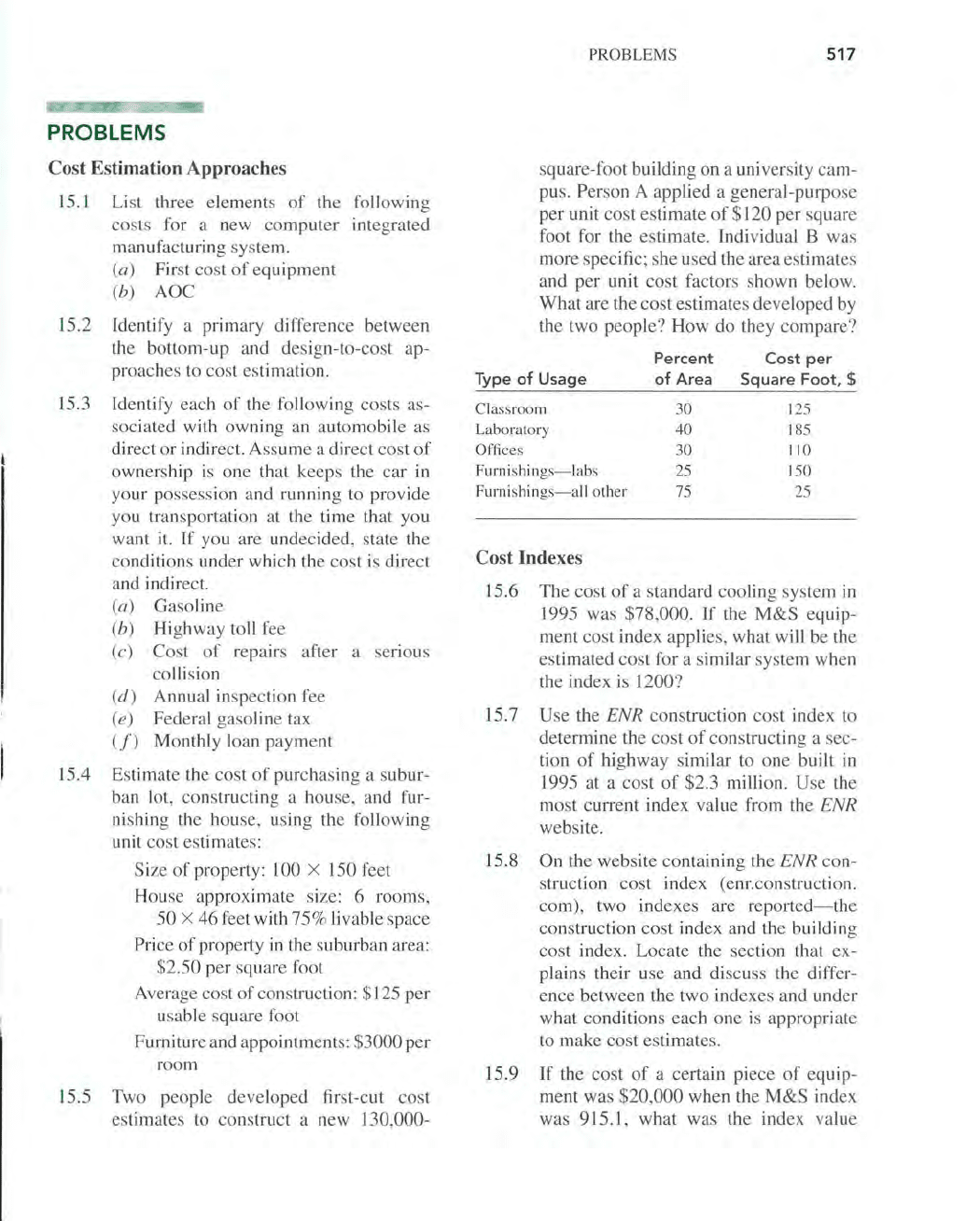
PROBLEMS
Cost Estimation Approaches
15.1 List three elements
of
the following
costs for a new computer integrated
manufacturing system.
(a) First cost
of
equipment
(b) AOC
15.2 Identify a primary difference between
the bottom-up and design-to-cost ap-
proaches to cost estimation.
15
.3 Identify each
of
the following costs as-
sociated with owning an automobile as
direct
or
indirect. Assume a direct cost
of
ownership
is
one that keeps the car in
your possession and running to provide
you transportation at the time that you
want
it.
If
you are undecided, state the
conditions under which the cost is direct
and indirect.
(a) Gasoline
(b) Highway toll fee
(c) Cost
of
repairs after a serious
collision
(d)
Annual inspection fee
(e)
Federal gasoline tax
(f)
Monthly loan payment
15.4 Estimate the cost
of
purchasing a subur-
ban
lot, constructing a house, and fur-
nishing the house, using the following
unit cost estimates:
Size
of
property: 100 X 150 feet
House approximate size: 6 rooms,
50 X
46
feet with 75% livable space
Price
of
property
in
the suburban area:
$2.50
per
square foot
Average cost
of
construction: $125 per
usable square foot
Furniture and appointments:
$3000 per
room
15
.5 Two people developed first-cut cost
estimates to construct a new
J
30
,000-
PROBLEMS
517
square-foot building on a university cam-
pus.
Person A applied a general-purpose
per unit cost estimate
of
$120 per square
foot for the estimate. Individual B was
more specific; she used the area estimates
and per unit cost factors shown below.
What
are the cost estimates developed by
the two people?
How
do they compare?
Percent
Cost
per
Type
of
Usage
of
Area
Square
Foot, $
Classroom
30
125
Laboratory
40
185
Offices
30
110
Furnishings-
labs
25
150
Furnishings-all
other
75
25
Cost Indexes
15
.6
The
cost
of
a standard cooling system
in
1995 was $78,000.
If
the M&S equip-
ment cost index applies, what will be the
estimated cost for a similar system when
the index
is
1200?
15.7
Use
the ENR construction cost index to
determine the cost
of
constructing a sec-
tion
of
highway similar to one built
in
1995 at a cost
of
$2.3 million. Use the
most current index value from the
ENR
website.
15.8
On the website containing the ENR con-
struction cost index (enr.construction.
com), two indexes are
reported-the
construction cost index and the building
cost index. Locate the section that ex-
plains their use and discuss the differ-
ence between the two indexes and under
what conditions each one is appropriate
to make cost estimates.
15
.9
If
the cost
of
a certain piece
of
equip-
ment was
$20,000 when the M&S index
was 915.1, what was the index value
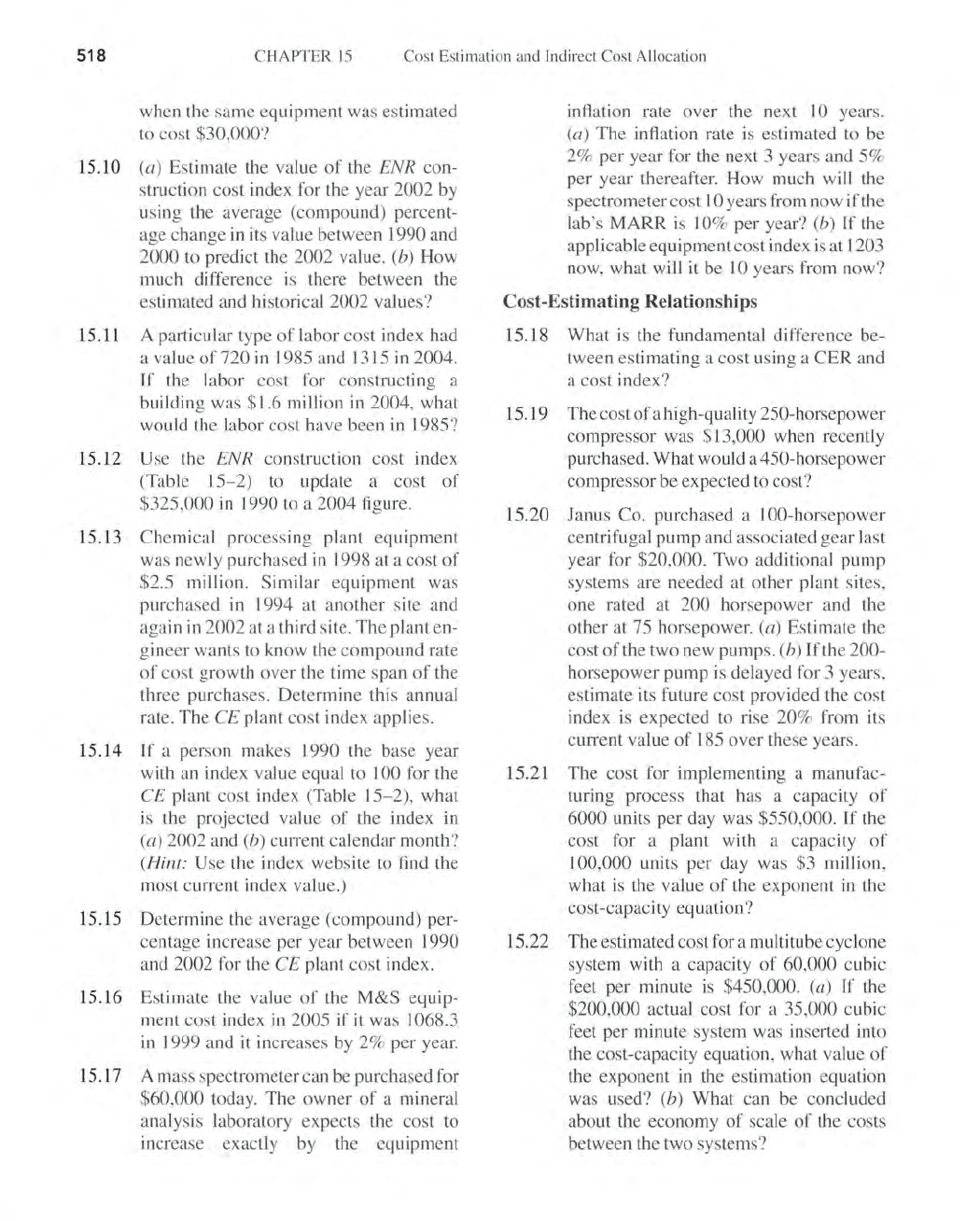
518 CHAPTER
IS
Cost Estimation
and
Indirect Cost Allocation
when the
same
equipment was estimated
to cost
$30
,
000
?
15
.
10
(a) Estimate the value
of
the ENR con-
struction cost index for the year 2002 by
using the average (compound) percent-
age change
in
its value between 1990 and
2000 to predict the 2002 value. (b) How
much difference is there between the
estimated and historical
2002 values?
15.11 A particular type
of
labor
cost
index had
a value
of
720
in
1985 and 1315
in
2004.
If the labor cost for constructing a
building was $1.6 million
in
2004,
what
would the labor cost have been
in
1985?
15.12 Use the ENR construction cost index
(Table
15-2)
to update a cost
of
$325,000
in
1990 to a 2004 figure.
15.13 Chemical processing plant
equipment
was newly purchased
in
1998 at a
cost
of
$2
.5 million. Similar
equipment
was
purchased
in
1994 at another site and
again
in
2002
at a third site.
The
plant en-
gineer
wants to
know
the
compound
rate
of
cost
growth
over
the time span
of
the
three purchases.
Determine
this annual
rate.
The
CE
plant
cost
index applies.
15
.14 If a person makes 1990 the base year
with an index value equal to 100 for the
CE
plant cost index (Table
15-2),
what
is
the projected value
of
the index in
(a) 2002 and (b) current calendar month?
(Hint:
Use
the index website to find the
most current index value.)
15.
15
Determine the average (compound) per-
centage increase per year between 1990
and 2002 for the
CE
plant cost index.
15.16 Estimate the value
of
the
M&S
equip-
ment
cost
index
in
2005 if it was 1068.3
in
1999 and it increases by 2% per year.
15
.17 A mass spectrometer can be purchased for
$60,000 today.
The
owner
of
a mineral
analysis laboratory expects the cost to
increase exactly by the equipment
inflation rate over the next
10
years.
(a)
The
inflation rate
is
estimated to be
2% per year for the next 3 years and 5%
per year thereafter.
How
much will the
spectrometer cost
10
years from now
if
the
lab's
MARR
is 10% per year? (b)
If
the
appl icable equipment cost index is at 1203
now, what will it be
10
years from now?
Cost-Estimating Relationships
15.18
What
is the fundamental difference be-
tween estimating a cost using a
CER
and
a cost index?
15
.
19
The cost
of
a high-q uali
ty
250-horsepower
compressor was $] 3,000 when recently
purchased. What would
a450-
horsepower
compressor be expected to cost?
15.20 Janus Co. purchased a 100-horsepower
centrifugal pump and associated gear last
year for
$20
,000. Two additional pump
systems are needed at other plant sites,
one
rated at 200 horsepower and the
other at 75 horsepower. (a) Estimate the
cost
ofthe
two new pumps. (b)
If
the 200-
horsepower
pump
is delayed for 3 years,
estimate its future cost provided the cost
index is expected to rise 20% from its
current value
of
185
over
these years.
15.
21
The
cost for implementing a manufac-
turing process that has a capacity
of
6000 units
per
day was $550,000.
If
the
cost
for a plant with a capacity
of
100,000 units
per
day was $3 million,
what is the value
of
the exponent
in
the
cost-capacity equation?
15.22
The
estimated cost for a multitube cycl
one
system with a capacity
of
60,000 cubic
feet per minute is
$450,000. (a) [f the
$200,000 actual cost for a 35,000 cubic
feet per minute system was inserted into
the cost-capacity equation, what value
of
the exponent in the estimation equation
was used?
(b) What can be concluded
about the economy
of
scale
of
the costs
between the two systems?
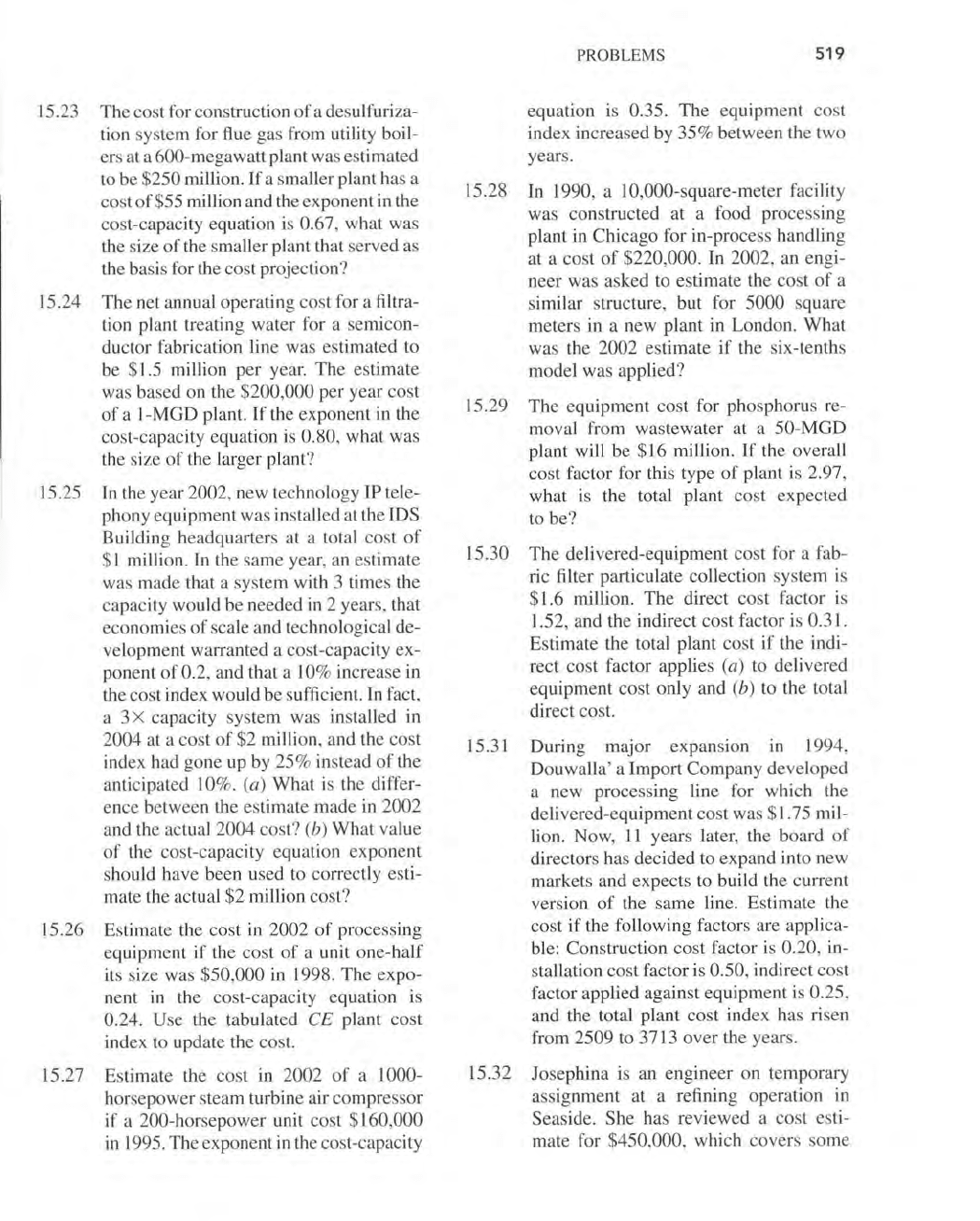
15
.23 The cost for construction
of
a desulfuriza-
tion system for flue gas from utility boil-
ers at a 600-megawatt plant was estimated
to be
$250 million.
If
a smaller plant has a
costof$55
million and the exponent in the
cost-capacity equation is
0.67, what was
the size
of
the smaller plant that served
as
the basis for the cost projection?
15
.24
The
net annual operating cost for a filtra-
tion plant treating water for a semicon-
ductor fabrication line was estimated to
be $1.5 million
per
year. The estimate
was based on the
$200,000 per year cost
of
a I-MGD plant.
If
the exponent in the
cost-capacity equation is
0.80, what was
the size
of
the larger plant?
15
.
25
In the year 2002, new technology
IP
tele-
phony equipment was installed
atthe
IDS
Building headquarters at a total cost
of
$1
million. In the same year, an estimate
was made that a system with 3 times the
capacity would be needed
in
2 years, that
economies
of
scale and technological de-
velopment warranted a cost-capacity ex-
ponent
of
0.2, and that a 10% increase in
the cost index would be sufficient. In fact,
a 3
X capacity system was installed
in
2004 at a cost
of
$2 million, and the cost
index had gone up by 25%
in
stead
of
the
anticipated
10
%. (a) What is the differ-
ence between the estimate made in
2002
and the actual 2004 cost? (b) What value
of
the cost-capacity equation exponent
should have been used to correctly esti-
mate the actual $2 million cost?
15
.26 Estimate the cost in 2002
of
processing
equipment if the cost
of
a unit one-half
its size was
$50,000
in
1998.
The
expo-
nent
111
the cost-capacity equation
is
0.24. Use the tabulated CE plant cost
index to update the cost.
15.27 E timate the cost in
2002
of
a 1000-
horsepower steam turbine air compressor
if a 200-horsepower unit cost
$160,000
in
1995.
The
exponent
in
the cost-capacity
PROBLEMS
519
equation
is
0.35.
The
equipment cost
index increased by 35% between the two
years.
15
.28 In 1990, a 1O,000-square-meter facility
was constructed at a food processing
plant
in
Chicago for in-process handling
at a cost
of
$220,000. In 2002, an engi-
neer was asked to estimate the cost
of
a
similar structure, but for
5000 square
meters
in
a new plant in London. What
was the
2002 estimate
if
the six-tenths
model was applied?
15.29
The
equipment cost for phosphorus re-
moval from wastewater at a 50-MGD
plant will be $16 million.
If
the overall
cost factor for this type
of
plant
is
2.97,
what
is
the total plant cost expected
to be?
15
.30
The
delivered-equipment cost for a fab-
ric filter particulate collection system
is
$1.6 mjllion.
The
direct cost factor is
1.52, and the indirect cost factor
is
0.31 .
Estimate the total plant cost if the indi-
rect cost factor applies
(a) to delivered
equipment cost only and
(b) to the total
direct cost.
15.31 During major expansion
In
1994,
Douwalla' a Import Company developed
a new processing line for which the
delivered-equipment cost was $1.75 mil-
lion. Now,
11
years later, the board
of
directors has decided to expand into new
markets and expects to build the current
version
of
the same line. Estimate the
cost
if
the following factors are applica-
ble: Construction cost factor
is
0.20, in-
stallation cost factor is
0.50, indirect cost
factor applied against equipment is 0.25,
and the total plant cost index has risen
from 2509 to 3713 over the years.
15.32 Josephina
is
an engineer on temporary
assignment at a refining operation
111
Seaside. She has reviewed a cost esti-
mate for
$450,000, which covers some
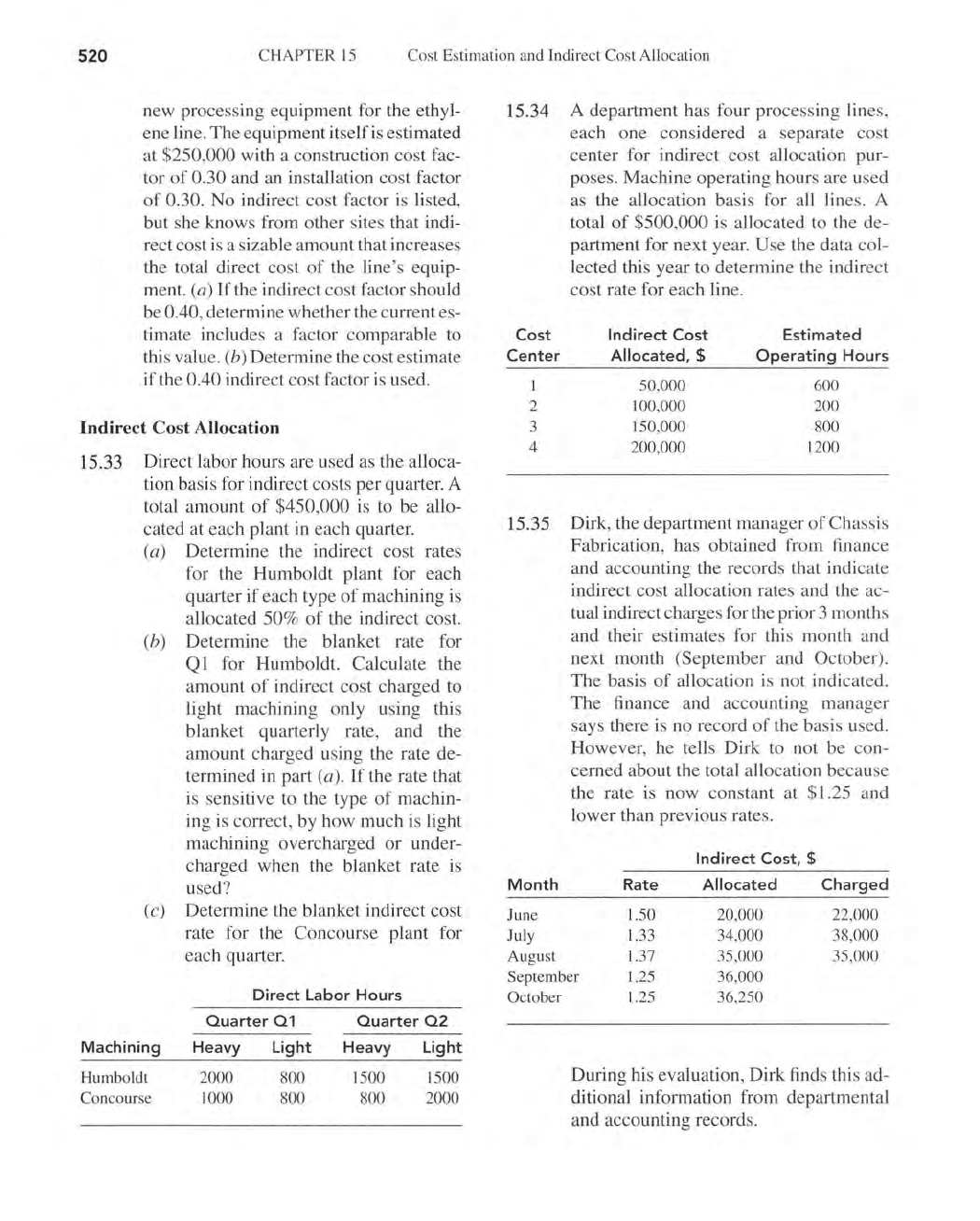
520
CHAPTER
15
Cost Estimation and Indirect Cost
Al
location
new processing equipment for the ethyl-
ene line.
The
eq
ui
pment itself is estimated
at
$250,000 with a construction cost fac-
tor
of
0.30 and an insta
ll
ation cost factor
of
0.30. No indirect cost factor is listed,
but she knows from other sites that indi-
rect cost is a sizable amount that increases
the
total direct cost
of
the line's equip-
ment.
(a)
If
the indirect cost factor should
be
0.40, detennine whether the current es-
timate includes a factor comparable to
th
is val ue. ( b) Determi ne the cost estimate
if the
0.40 indirect cost factor
is
used.
Indir
ect Cost Allocation
15.33 Direct labor hours are used as the alloca-
tion basis for indirect costs per quarter. A
total amount
of
$450,000
is
to be allo-
cated at each plant
in
each quarter.
(a) Determine the indirect cost rates
for the Humboldt plant for each
quarter if each type
of
machining is
allocated
50%
of
the indirect cost.
(b) Determine the blanket rate for
Ql
for Humboldt. Calculate the
amount
of
indirect cost charged to
light machining only using this
blanket quarterly rate, and the
amount charged using the rate de-
termined in part
(a).
If
the rate that
is
sensitive to the type
of
machin-
ing
is
correct, by how much
is
light
machining overcharged or under-
charged when the blanket rate is
used?
(c) Determine the blanket indirect cost
rate for the Concourse plant for
each quart
er.
Machini
ng
Humboldt
Concourse
Direct
Labor
Hours
Qua
r
te
r Q1
Heavy
2000
1000
Light
800
800
Qua
r
ter
Q2
Heavy
1500
800
Light
1500
2000
15
.
34
A department has four processing lines,
each one considered a separate cost
center for indirect cost allocation pur-
poses. Machine operating hours are used
as
the allocation basis for all lines. A
total
of
$500,000 is allocated to the de-
partment for next year.
Use the data col-
lected this year to determine the indirect
cost rate for each line.
C
os
t Indir
ect
Cos
t
Estimate
d
C
ente
r
Allocat
ed
, $
Opera
t
in
g Hours
50,000 600
2 100,000 200
3
150,000
800
4 200,000 1200
15
.35 Dirk, the department manager
of
Chassis
Fabrication, has obtained from finance
and accounting the records that indicate
indirect cost allocation rates and the ac-
tual indirect charges for the prior 3 months
and their estimates for this month and
next month (September and October).
The
basis
of
allocation is not indicated.
The
finance and accounting manager
says there
is
no record
of
the basis used.
However, he tells Dirk to not be con-
cerned about the total allocation because
the rate is now constant at
$1
.25 a
nd
lower than previous rates.
I
nd
i
rect
Cos
t,
$
Mon
th
Rate
All
o
cate
d C
harge
d
June
1.50 20,000 22,000
July
1.33
34,000
38
,000
August 1.37
35
,000 35,000
September
1.25
36,000
October 1.25 36,250
During his evaluation, Dirk finds this ad-
ditional information from departmental
and accounting records.
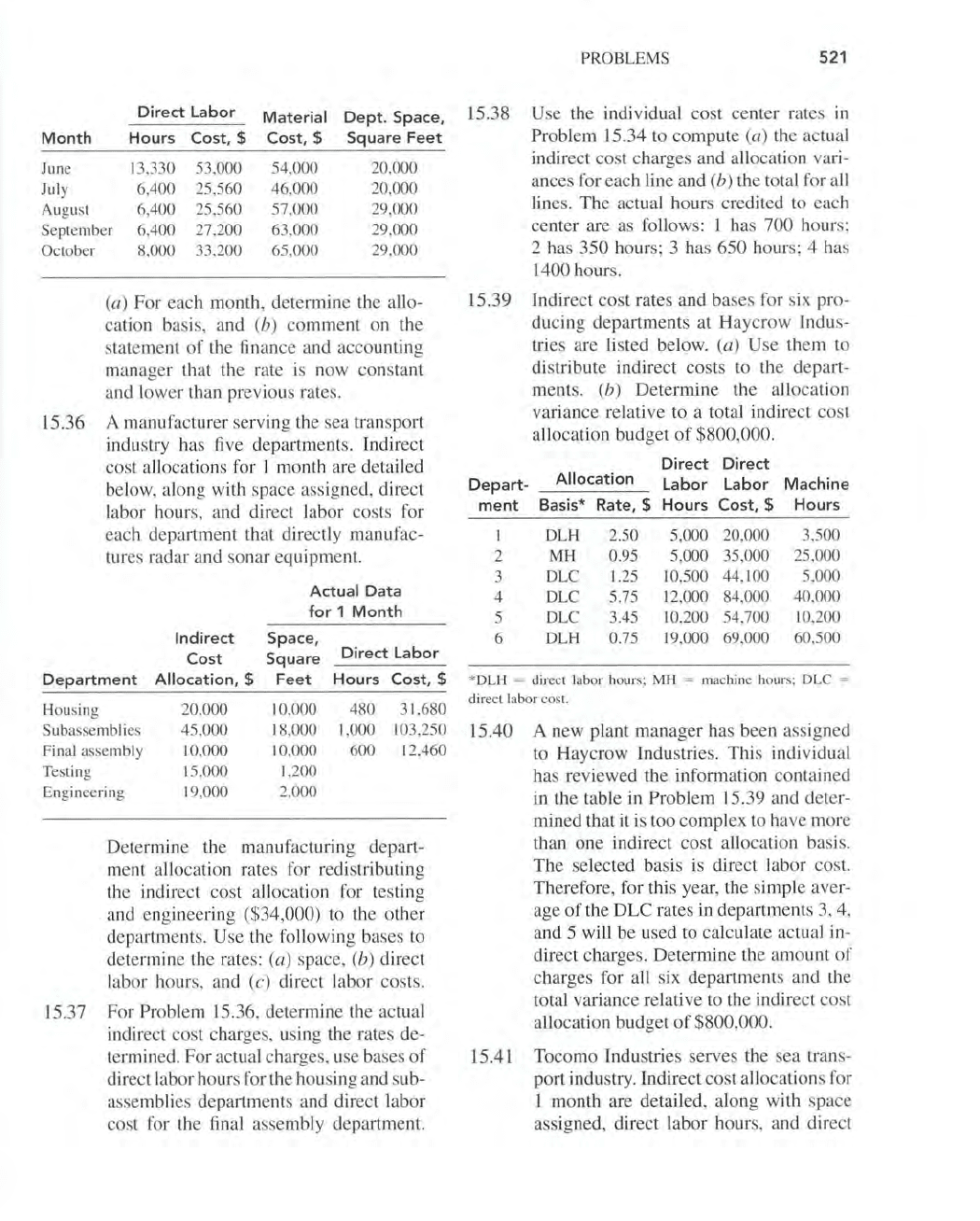
Direct
Labor
Material
Dept
.
Space,
Month
Hours
Cost,
$
Cost,
$
Square
Feet
June 13,330
53,000 54,000 20,000
July 6,400
25,560
46,000
20,000
August
6,400 25,560
57.000
29
,000
September
6,400 27,200
63
,000 29,000
October
8,000 33,200
65
,000
29,000
(a)
For
each month, determine the allo-
cation basi
s,
and (b)
co
mment on the
statement
of
the finance and accounting
man
age
r that the rate is n
ow
constant
and lower than previous rates.
15.36 A manufacturer serving the sea transport
industry has five department
s.
Indirect
cost allocations for 1 month are detailed
below, along with space assigned, direct
labor hours, and direct labor costs for
each department that directly manufac-
tures rad
ar
and sonar equipment.
Actual
Data
for
1
Month
Indirect
Space,
Cost
Square
Direct
Labor
Department
Allocation, $
Feet
Hours
Cost,
$
Housing
20,000 10,000 480
31,680
Subassemblies 45,000 18,000
1,000
10
3,250
Final
assemb
ly
10
,000
10
,000 600
12,460
Test
in
g
15
,000 1,200
Engineering 19,000 2,000
Determine the ma
nuf
acturing depart-
ment a
ll
ocation rates for redistributing
th
e indir
ect
cost allocation for testing
a
nd
engineering ($34,000) to the
ot
her
departments.
Use
the following bases to
determine the rates: (a) space, (b) direct
labor hours, and (c) direct labor costs.
15.37
For
Problem
15
.3
6, determine the actual
indirect cost charges, us
in
g the rates de-
termined. For actual charges, use bases
of
dir
ect
labor hours for the hous
in
g a
nd
sub-
assemb
li
es departments and dir
ec
t labor
cost for the final assembly department.
15.38
PROBLEMS
521
Use the individual cost center rates
in
Problem
15
.3
4 to compute (a) the actual
indirect cost charges and a
ll
ocation var
i-
ances for each line and (b) the total for a
ll
lines.
The
actual hours credited to each
center are as follows: 1 has
700 hours;
2 has
350
hour
s;
3 has 650 hours; 4 has
1400 hour
s.
15.39 Indirect
cost
rates and bases for six pro-
ducing departments at Haycrow Indus-
tries are
li
sted below. (a)
Use
them to
distribute indir
ec
t
cost
s to the depart-
ments. (b)
Determine
the a
ll
ocat
ion
variance relative to a total indir
ect
cost
allocation
budget
of
$800,000.
Direct
Direct
Depart-
Allocation
Labor
Labor Machine
ment
Basis* Rate, $ Hours
Cost,
$
Hours
OLH
2.
50 5,000 20,000
3,500
2
MH
0.95 5,000
35
,000
25,000
3 OLe
1.
25
10
,500 44,
100
5,000
4 OLe 5.
75
12,000 84,000 40,000
5
OLe 3.45
10,200 54,700 10,200
6
DLH
0.75
19
,000
69
,000
60,500
*OLH = direct labor hour
s;
MH
= machine hours;
OLe
=
direct labor cos
t.
15.40 A new plant
manager
has b
ee
n assigned
to Haycrow Industries. This individual
has reviewed the information conta
in
ed
in the table
in
Problem 15.39 and deter-
mined that
it
is too complex to have more
than one indirect cost allocation basi
s.
The
sel
ec
ted basis is dir
ect
labor cost.
Therefore, for this year, the
si
mple
ave
r-
age
of
the
DLC
rates in departments 3, 4,
and 5 will be used to calculate actual
in
-
dir
ec
t charges. Determine the amount
of
charges for a
ll
six departments and the
total variance relative to the indirect cost
a
ll
ocation budget
of
$800,000.
15.41 Tocomo Industries serves the sea trans-
port industry. Indirect cost allocations for
1 month are detailed, along with space
assigned, direct labor hours, and dir
ect
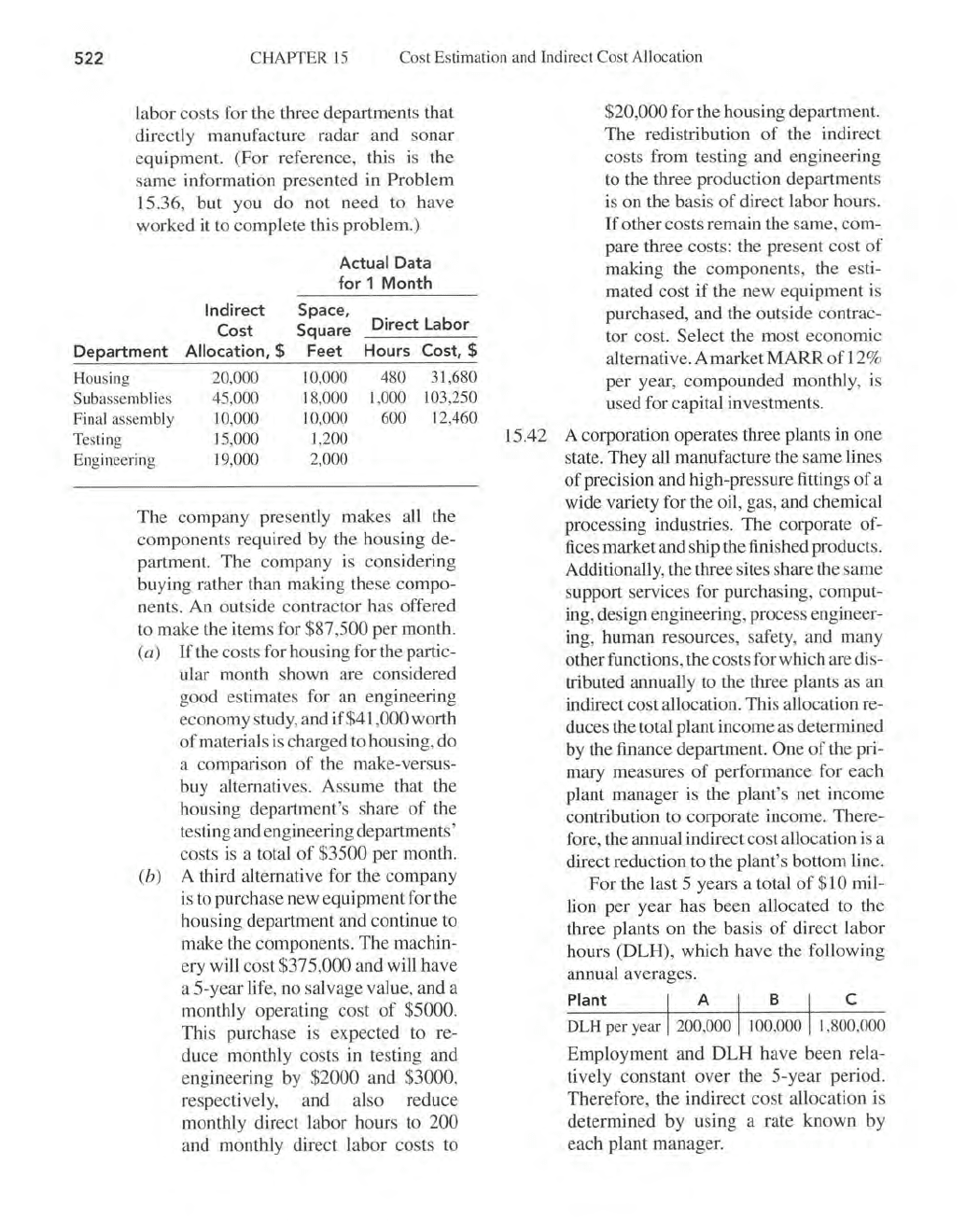
522
CHAPTER
15
Cost Estimation and Indirect Cost Allocation
labor costs for the three departments that
directly manufacture radar and sonar
equipment. (For reference, this is the
same
information presented in Problem
15.36, but you do not need to have
worked it to complete this problem.)
In
direct
Cost
Actual
Data
for
1
Month
Space,
Direct
Labor
Square
De
partm
e
nt
Allocation, $
Feet
Hours
Cost,
$
Housing
20,000
10
,000 480
31
,680
Subassemblies
45,000
18
,000
1,000
103,250
Final assembly 10,000
10
,000
600
12,460
Te
sting
15,000 1,200
Engineering
19,000 2,000
The
company presently makes all the
components required by the housing de-
partment.
The
company
is
considering
buying rather than making these compo-
nents. An outside contractor has offered
to make the items for
$87,500 per month.
(a)
If
the costs for housing for the partic-
ular month shown are considered
good estimates for an engineering
economy study, and if$41
,000 worth
of
materials
is
charged to housing, do
a comparison
of
the make-versus-
buy alternatives. Assume that the
housing department's share
of
the
testing and engi neering departments'
costs is a
total
of
$3500 per month.
(b) A third alternative for the company
is
to purchase new equipment for the
housing department and continue to
make the components. The machin-
ery will cost
$375,
000
and will have
a 5-year life, no salvage value, and a
monthly operating cost
of
$5000.
This purchase
is
expected to re-
duce monthly costs in testing and
engineering by
$2000 and $3000,
respectively, and also reduce
monthly direct labor hours to
200
and monthly direct labor costs to
$20,000 for the housing department.
The
redistribution
of
the indirect
costs from testing and engineering
to the three production departments
is on the basis
of
direct labor hours.
If
other costs remain the same, com-
pare three costs: the present cost
of
making the components, the esti-
mated cost
if
the new equipment is
purchased, and the outside contrac-
tor cost. Select the most economic
alternative. A market
MARR
of
12 %
per year, compounded monthly, is
used for capital investments.
15.42 A corporation operates three plants in one
state. They all manufacture the same lines
of
precision and high-pressure fittings
of
a
wide variety for the oil, gas, and chemical
processing industries. The corporate of-
fices market and ship the finished products.
Additionally, the three sites share the same
support services for purchasing, comput-
ing, design engineering, process engineer-
ing, human resources, safety, and many
other functions, the costs for which are dis-
tributed annually to the three plants as an
indirect cost allocation. This allocation re-
duces the total plant income as determined
by the finance department.
One
ofthe
pli-
mary measures
of
performance for each
plant manager is the plant's net income
contribution to corporate income. There-
fore, the annual indirect cost allocation is a
direct reduction to the plant's bottom line.
For
the last 5 years a total
of
$10 mil-
lion
per
year has been allocated to the
three plants on the basis
of
direct labor
hours (DLH), which have the following
annual averages.
Pla
nt
A C
DLH per year 200,000 1,800,000
Employment and
DLH
have been rela-
tively constant over the 5-year period.
Therefore, the indirect cost allocation is
determined by using a rate known by
each plant manager.
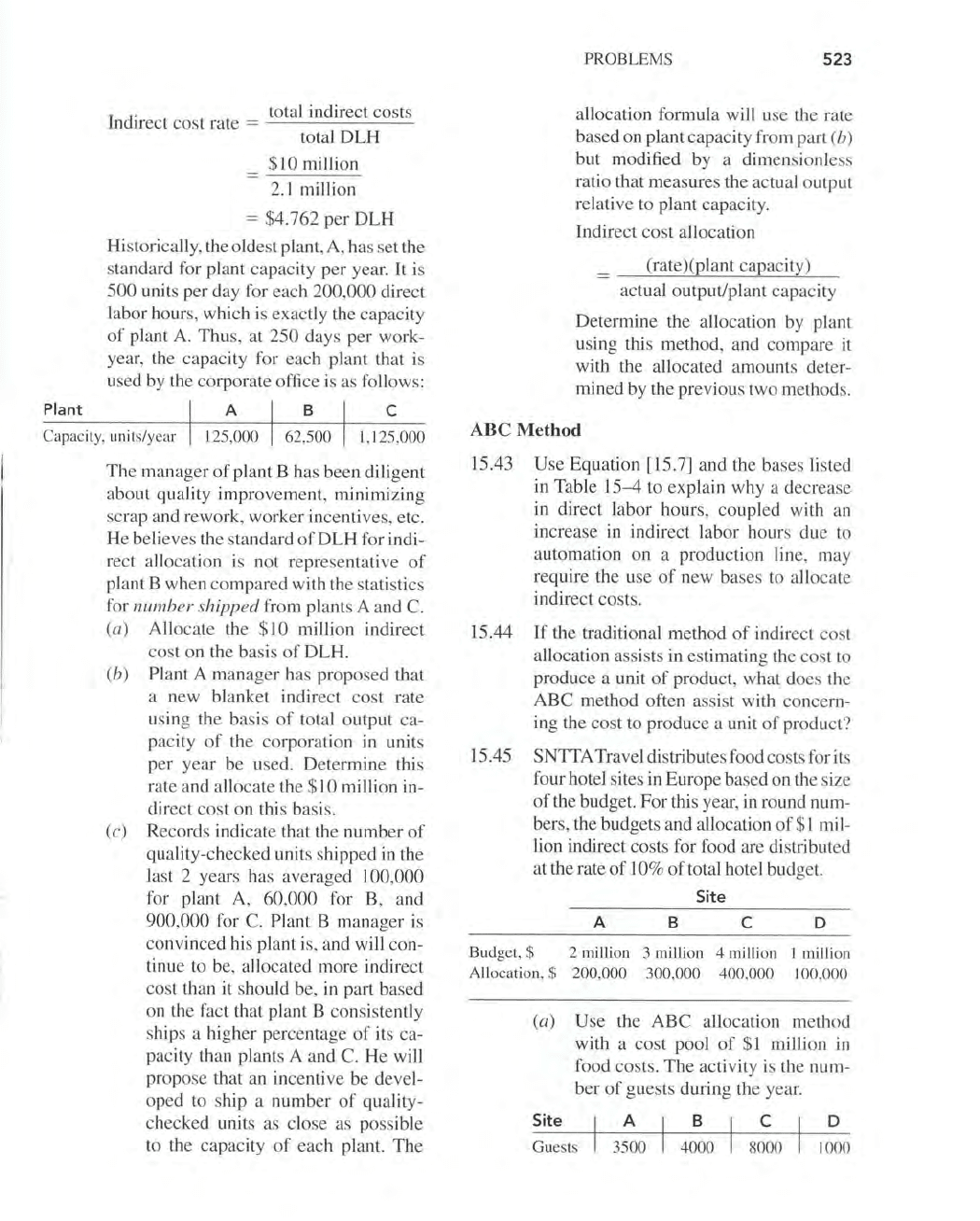
I d
· total indirect costs
n (rect cost rate
= D
total
LH
$10 million
2.1
million
= $4.762
per
DLH
Hi
stor
ically, the oldest plant, A, has set the
standard for plant capacity per year.
It
is
500 units per day for each 200,000 direct
labor hours, which is exactly the capacity
of
plant
A.
Thus, at 250 days per work-
year, the capacity for each plant that is
used by the corporate office
is
as follows:
Plant
ABC
Capacity, units/year
1,125,000
The
manager
of
plant B has been diligent
about quality
improvement
, minimizing
scrap and rework, worker incentives, etc.
He
believes the standard
ofDLH
for indi-
rect allocation is not representative
of
plant B when
compared
with the statistics
for number shipped from plants A and C.
(a) Allocate the
$10
million indirect
cost on the basis
of
DLH
.
(b) Plant A manager has proposed that
a new blanket indir
ect
cost rate
using the basis
of
total output ca-
pacity
of
the corporation
in
units
per year be used. Determine this
rate and allocate the
$1
0 million in-
direct
cost
on this basis.
(c) Records indicate that the number
of
quality-checked units shipped in the
last 2 years has averaged 100,000
for plant A, 60,000 for B, and
900,000 for C. Plant B manager is
convinced his plant is, and will con-
tinue to be, allocated more indirect
cost than it should be,
in
part based
on the fact that plant B consistently
ships a higher percentage
of
its ca-
pacity than plants A and C.
He
will
propose that an incentive be devel-
oped to ship a number
of
quality-
checked units as close as possible
to the capacity
of
each plant.
The
PROBLEMS
523
allocation formula will use the rate
based on plant capacity from part (b)
but modified by a dimensionless
ratio that measures the actual output
relative to plant capacity.
Indirect cost allocation
(rate )(plant capacity)
actual output/plant capacity
Determine the allocation by plant
using this method, and compare it
with the allocated amounts deter-
mined by the previous two methods.
ABC Method
15.43
Use
Equation [15.7] and the bases listed
in
Table
15-4
to explain why a decrease
in direct labor hours, coupled with an
increase in indirect labor hours due to
automation on a production line, may
require the use
of
new bases to allocate
indirect costs.
15.44
If
the traditional method
of
indirect cost
allocation assists
in estimating the cost to
produce a unit
of
product, what does the
ABC
method often assist with concern-
ing the cost to produce a unit
of
product?
15.45 SNTTA Travel distributes food costs for its
four hotel sites in Europe based on the size
of
the budget.
For
this year, in round num-
bers, the budgets and allocation
of
$1
mil-
lion indirect costs for food are disuibuted
at the rate
of
10%
of
total hotel budget.
Site
A B
C D
Budget,
$ 2 million 3 million 4 million I million
Allocation,
$ 200,000 300,000 400,000 100,000
(a)
Use
the
ABC
allocation method
with a
cost
pool
of
$1
million
in
food costs.
The
activity is the num-
ber
of
guests during the year.
S~e
I A I B I C I D
Guests 3500 4000 8000 1000
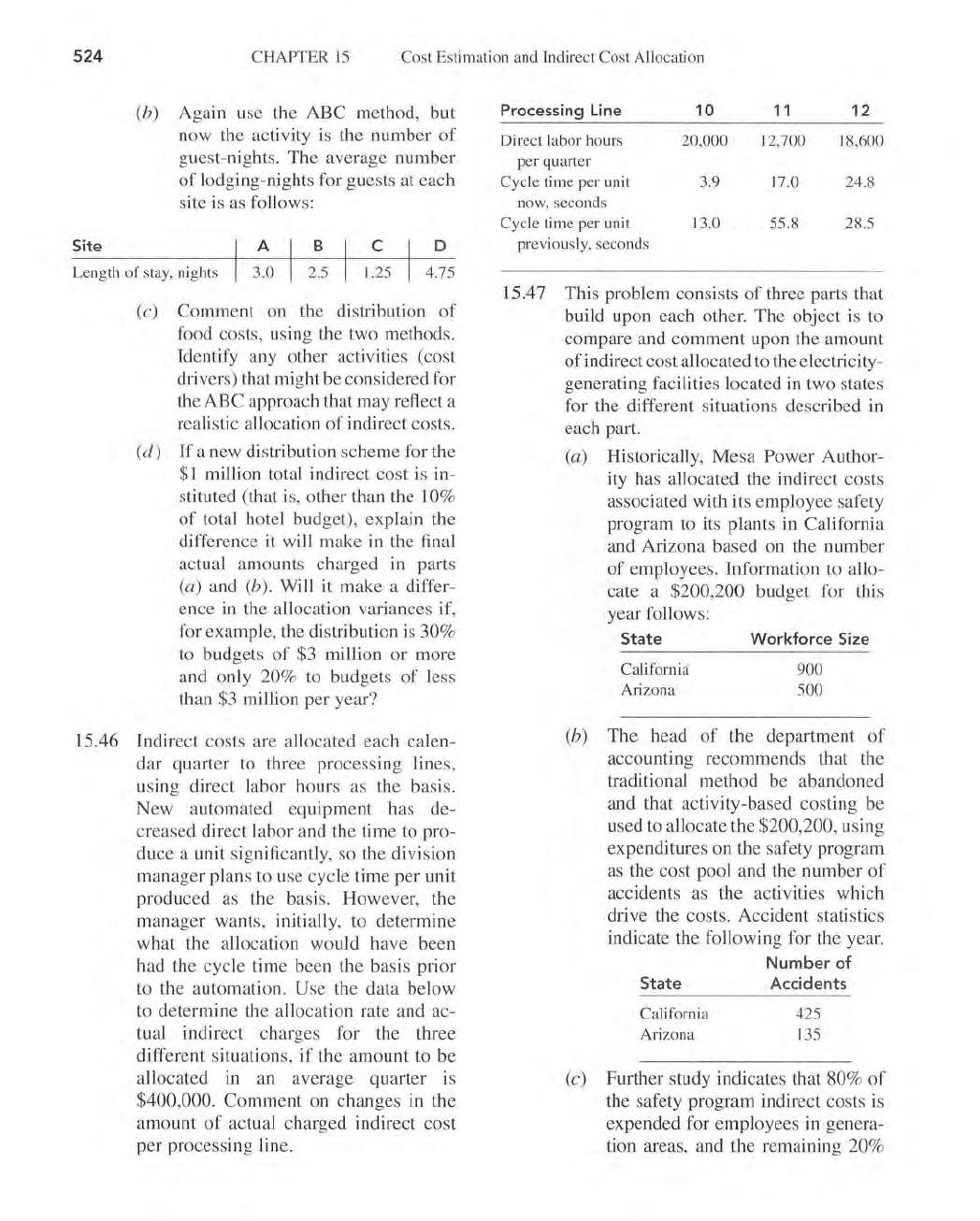
524
CHAPTER
15
Cost Estimation and Indirect Cost Allocation
(b) Again use the ABC method, but
now the activity
is
the number
of
guest-nights. The average number
of
lodging-nights for guests at each
site
is
as follows:
Site D
Length
of
stay, nights 4.75
(c) Comment on the distribution
of
food costs, using the two methods.
Identify any other activities (cost
drivers) that might be considered for
the ABC approach that may reflect a
realistic allocation
of
indirect costs.
(d)
If
a new distribution scheme for the
$1
million total indirect cost is in-
stituted (that is, other than the
10%
of
total hotel budget), explain the
difference
it
will make in the final
actual amounts charged in parts
(a) and (b). Will it make a differ-
ence
in
the allocation variances if,
for example, the distribution is
30%
to budgets
of
$3 million or more
and only
20% to budgets
of
less
than $3 million per year?
15.46 Indirect costs are allocated each calen-
dar quarter to three processing lines,
using direct labor hours as the basis.
New automated equipment has de-
creased direct labor and the time to pro-
duce a unit significantly, so the di vision
manager plans to use cycle time
per
unit
produced as the basis. However, the
manager wants, initially, to determine
what the allocation would have been
had the cycle time been the basis prior
to the automation.
Use the data below
to determine the allocation rate and ac-
tual indirect charges for the three
different situations,
if
the amount to be
allocated in an average quarter is
$400,000.
Comment
on changes in the
amount
of
actual charged indirect cost
per processing line.
Processing Line
10
11
12
Direct labor hours
20,000 12,700
18
,600
per quarter
Cycle time per unit
3.9
17.0 24.8
now, seconds
Cycle time per unit
13
.0
55.8 28.5
previously, seconds
15.47 This problem consists
of
three parts that
build upon each other.
The
object is to
compare and comment upon the amount
of
indirect cost allocated to the electricity-
generating facilities located
in
two states
for the different situations described
in
each part.
(a) Historically,
Mesa
Power Author-
ity has allocated the indirect costs
associated with its employee safety
program to its plants in California
and Arizona based on the number
of
employees. Information to allo-
cate a
$200,200 budget for this
year follows:
State
California
Arizona
Workforce Size
900
500
(b) The head
of
the department
of
accounting recommends that the
traditional method be abandoned
and that activity-based costing be
used to allocate the
$200,200, using
expenditures on the safety program
as
the cost pool and the number
of
accidents as the activities which
dri ve the costs. Accident statistics
indicate the following for the year.
(c)
State
California
Arizona
Number
of
Accidents
425
135
Further study indicates that 80%
of
the safety program indirect costs
is
expended for employees
in
genera-
tion areas, and the remaining
20%
